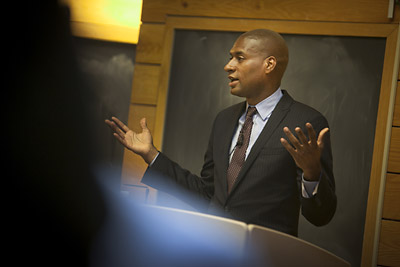Murky media landscape endangers democracy, says New York Times columnist
By George Lowery

If it weren't for young African-American male bloggers who took it upon themselves to uncover the details of the Feb. 26, 2012, killing of Florida teenager Trayvon Martin, the case never would have made national news.
So said New York Times op-ed columnist and blogger Charles M. Blow in his Daniel W. Kops Freedom of the Press Lecture on campus Sept. 20.
Blow said he learned of Martin's killing through tweets from people who asked him why he wasn't writing about it. Blow's first column on Martin's killing appeared March 16, when he wrote: "As the father of two black teenage boys, this case hits close to home. ... That it might all end with a hole in their chest and a hole in my heart. ..."
The Martin case throws a spotlight on the new news landscape, Blow said, in which anyone can and does say anything, often with scant reference to facts.
Blow made the case that some of today's news consumers make little distinction between straight reporting and agenda-driven advocacy and activism, and they consume what passes as news from sources whose accuracy and legitimacy they do not question.
Blow identified himself as purveyor of opinions: "I get paid to not go straight down the middle. I get paid to tell you what I feel about things." Which can be risky, he said, as lines blur. But young readers of news with no exposure to physical newspapers -- who receive information from the Internet's "flattened-out space" -- are not aware of distinctions between the reporting of facts and opinion writing that appear on separate, clearly labeled pages, Blow said.
In the Martin case, which Blow called an "American tragedy," some facts of the encounter between Martin and his killer, George Zimmerman, remain in dispute.
Martin was returning to his father's girlfriend's apartment in Sanford, Fla., when he caught the eye of Zimmerman, coordinator of the complex's neighborhood watch. Zimmerman, who was armed, called the police to report a suspicious character who might be on drugs, was wearing a gray hoodie and might be black.
In addition to his hooded sweatshirt, Martin wore "grills" -- jewelry -- on his teeth, Blow said, which was widely connoted to mean "thug." But when Olympian Ryan Lochte wore them in London, "no one suggested that he was, in fact, a thug."
Martin, on the phone to his girlfriend, told her a strange guy was watching him; she told Martin to run. Zimmerman, in his car and on the phone to the police, said Martin was running. The police told Zimmerman not to follow Martin. There are conflicting accounts of a physical altercation between the two.
"And then George Zimmerman shoots Trayvon Martin in the chest and he is killed," Blow said. "This is where the media part of this kicks in."
Young male black bloggers at the Huffington Post and the Atlantic wrote about the case. "And in my first column, I also write about it in a very passionate and personal kind of way, and I'm very unapologetic about that fact," Blow said.
Why do people care so much about this case? Blow asked. "For many people, this case was not about an extraordinary death. It was about an extraordinary inequity in application of justice. This case was about who is deserving of the presumption of guilt or innocence."
When President Obama said, "If I had a son, he'd look like Trayvon," the case became instantly politicized and "ideologically charged," Blow said. Martin became fodder for the left and the right, grist for the mills of opinion and advocacy.
Blow remarked that the O.J. Simpson case provoked similar interest, but at that time "there was no partisan television, no Fox News, no MSNBC." Both sides began to "shop for favorable coverage," Blow said, including Martin's family, which hired a public relations agent.
Ultimately, Blow said, today's murky media landscape is a threat to democracy.
The lecture was supported by the Kops Freedom of the Press Fellowship Program, established in 1990 by Daniel W. Kops '39, a former editor of The Cornell Daily Sun, and was hosted by the College of Arts and Sciences in cooperation with the American Studies Program.
Media Contact
Get Cornell news delivered right to your inbox.
Subscribe